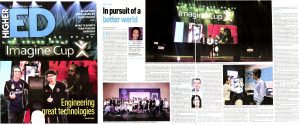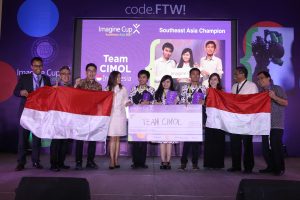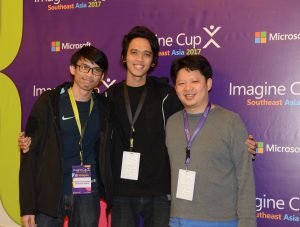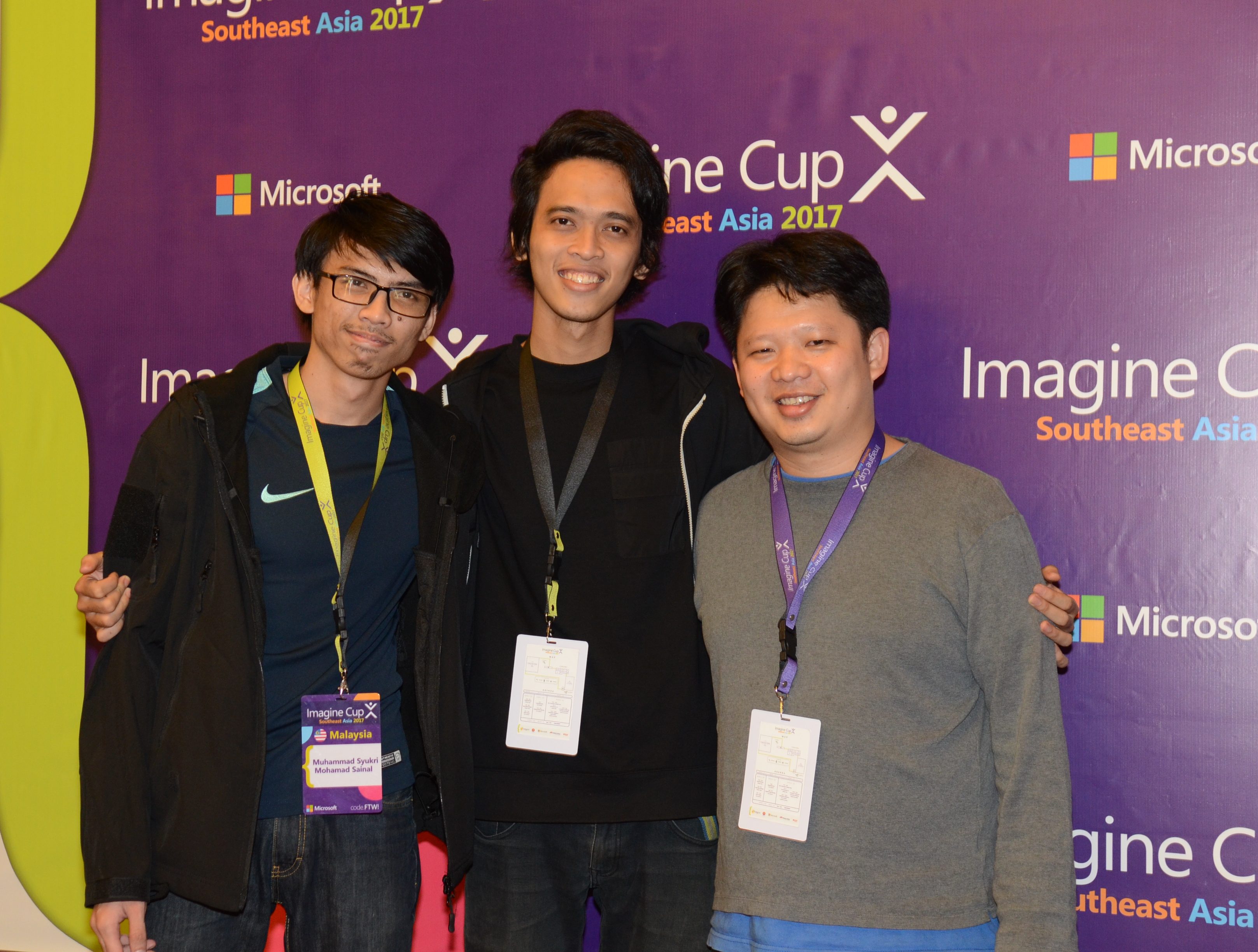The New Straits Times traveled to Manila for the finals of Imagine Cup SA 2017. The NST did an in-depth feature on the Imagine Cup, where 10 teams from SEA battled for a chance to represent the region at the global level of the competition. Read the print story here
BEING able to improve the lives of fellow humans or even to make the world a better place to live in is truly noble.

Not many of us can boast of having done even a little bit to help improve the quality of life for the human race, let alone conceptualise and build a technological invention that could benefit millions across the globe.
Thousands of talented youths from around the world have been trying to do all these for the past 15 years through Microsoft’s Imagine Cup.
Dubbed the Olympics of Student Technology Competitions, the Imagine Cup is an annual global student technology contest which aims to help unleash the potential of young talents in turning great ideas into reality. Through its mastery of technology, the young generation of today has realised many innovations.
This year, in its inaugural Southeast Asian Regional Finals in Manila, the Philippines on April 24, 10 teams from the Philippines. Indonesia, Bangladesh. Nepal, Sri Lanka, Thailand, Laos, Singapore, Vietnam and Malaysia battled for the top three spots and the chance to represent the region at the global 2017 Imagine Cup Finals to be held in Seattle in the United States in July. The World Finals will gather more than 50 student teams from all over the world, vying for the top prize of US$100,000 (RM432.900), mentorship opportunities with Microsoft chief executive officer Satya Nadella, as well as Azure grants and credits to commercialise their winning solution.
Out of the 10 Southeast Asia teams, six teams presented new technologies to improve the lives of people across the globe. Team CIMOL from Indonesia, for example, won the top prize in the Southeast Asian regional leg with its Hoax Analyser, a web-based app to combat fake news.

With the proliferation of fake news in today’s connected world, the app aims to assist users by identifying if certain contextual information can be categorised as hoaxes or not. All a user needs to do is run the text through the app and get a diagnosis.
Malaysia was represented by Team Solvere, made up of Nik Ahmad Faisal Mohd Kamarolzaman and Muhammad Syukri Mohamad Sainal, both final-year mechatronics engineering students at the Faculty of Electrical Engineering. Universiti Teknologi Malaysia (UTM). Their invention, the SmadBot, is essentially an interactive advertising robot that seeks to engage consumers and turn their interaction into sales. Though they did not make it to the World Finals, their invention still has all the qualities that spell success in the real world.
“Even though the SmadBot is created for advertising purposes, the interactive board can also be customised for use in public places such as airports, museums and even at clothing stores to suggest suitable clothes for users based on their size and shape.” explained Nik Ahmad Faisal in a question-and-answer session at the end of a presentation.
CHALLENGES
From the start of its journey, Team Solvere had been beset by setbacks. The question as to why there were only two members in their team was answered by Muhammad Syukri.
“We do have a third team member, Zul Fahmi Khamiti. But he had to fly off to the US to compete in another robotics competition,” he said.

Team Solvere was the only team with-two members presenting its invention, instead of the usual three. This could have been a handicap, but the boys took it all in stride and made the best out of the situation.
Nik Ahmad Faisal and Muhammad Syukri were accompanied by their mentor. Dr Yeong Che Fai, a senior lecturer in embedded systems and robotics a UTM. Yeong is also Nik Ahmad Faisal’s final-year project supervisor.
When met at the lobby of Solaire Resort and Casino, where the Imagine Cup SEA Finals were to be held, they looked like they could use a few hours of sleep. They have had quite a long and challenging night, having flown in late the night before on a Philippine Airlines-sponsored flight from Singapore, and arriving in Manila in the wee hours of the morning. They could not check into their hotel room but luckily a good Samaritan offered them a room while waiting for theirs to be ready.
On top of that, the resort and casino had a security policy that barred the team from bringing in its robot to the competition venue. After a round of negotiation and some intervention from the Microsoft representative, Team Solvere was finally able to retrieve its equipment and assemble its robot.
But to its dismay, the screen of the new display monitor had cracked. The team members and Yeong did not let challenges hold them back. So while Muhamad Syukri assembled the robot, Nik Ahmad Faisal began finalising the presentation slides and script.
It took two months to build the robot from scratch and make it function. During the initial stage, Muhamad Syukri was tasked with learning the robotics aspects to be applied to their invention. Zul Fahmi researched electronics and the mechanism for the robot, while Nik Ahmad Faisal was in charge of programming it.
“What we learnt in our major at university wasn’t enough to enable us to build this invention – it only provided basic knowledge,” said Muhammad Syukri.
“We received a lot of assistance from Dr Yeong, who is renown for bringing academic innovations to the market, as well as from companies which believed in our product.” he added.
ADVERTISEMENT FACTOR
When the answer to the question he asked, “Did you notice the advertisement and signboards on your way to this hall?” was met with a resounding “No!”, he went on to show them that with a declining marketing budget, digital billboards can be the solution to the problem of ineffective advertising. A Nielsen Digital Billboard study in 2015. conducted in the US, showed that 71 percent of digital billboard viewers feel such billboards stand out more than online ads.
Recognising this behavioral pattern, Nik Ahmad Faisal said that the team decided to invest in a smart robotic advertising billboard that combines smart ads with gamification. Through controlled testing at a shopping mall, it found that consumers were more inclined to interact with the SmadBot which has character. It then customised its invention to look like a penguin, calling it Pingu.
“The Nielsen research in 2015 also showed that trends for digital signage could bring in US$13.2 billion annually by 2016,” said Nik Ahmad Faisal.
“Using Microsoft Cognitive Services,” he added, “data analysis shows that our smart advertising solution can effectively deliver content in a cool and fun way.”
HELPING HAND
The SmadBot prototype costs RM20.000. “Without assistance for the robotic parts, we wouldn’t have been able to make our invention,” said Muhammad Syukri.
Yeong concurred, saying: “The robot components are mostly expensive but the team managed to secure some parts on loan from DF Automation & Robotics Sdn Bhd and Pepperl+Fuchs International, a supplier of industrial sensors and factory automation parts.”
As a university lecturer, Yeong not only deals with a pool of bright young students but also has access to grants and funding for research and development. In the United Kingdom, he came across students who did things that would impact mankind by commercialising their products. This is the knowledge he imparts to his students so their projects will be deemed worthwhile.
On what they have learnt from their Imagine Cup journey, the Team Solvere members said: “We need to brush up on our communication and management skills. If not. we may make the same mistakes in the future, which is doing things at the last minute and not being clear on each team member’s responsibilities.”
DISRUPTIVE IDEAS
In addition to its local partners, Microsoft provides disruptive technology to all the teams which get tech support, access to cloud computing, mentoring and education in coding.
All the participating teams in Microsoft’s Imagine Cup integrate the Microsoft Cloud Service platform. Microsoft Azure, into their inventions.
Microsoft Asia Pacific developer experience lead Dave Miller has the important task of helping students develop products using its products. “For the past 15 years, Imagine Cup has been a platform to help students turn their dreams into reality. This year’s regional finalists brought great ideas to the stage, and we see a lot of potential in these projects in solving some of the biggest challenges across the region today,” he said.
He added that we have now reached a critical stage where companies in Southeast Asia are mulling the adoption of new technology. Microsoft is seeing more partnerships with government bodies that indicate an interest in technology readiness. An example is its partnership with Malaysia Digital Economy Corporation.
“On the part of governments, there is a marked interest in more tech in order to bring more impact.”
Students were asked to incorporate three smart tech tools – artificial intelligence, augmented reality and Internet of Things – into their inventions. “They can use these across the board to improve lives,” added Miller.
One of the judges. Dr Jennifer Tang, was a member of the winning team at the global Imagine Cup Finals in 2014 for its simple, non-invasive screening tool for anaemia, Eyenaemia. She said: “More people are recognising problems and are looking for ways to solve them. This is the start of disruptive ideas or products.”
On the participants’ performance during their pitch, Dr Tang said it is important for the team to convey its message effectively to the judges and the audience. “There is a change in this year’s participation. There are more products that appear to be solutions to medical problems and a focus on improving the quality of life in general.”
“The current digital revolution offers opportunities for developing markets and has also made information more readily accessible.”
Before announcing the top three finalists for the SEA Finals 2017 Imagine Cup, Dr AKP Mochtan, Asean deputy secretary-general for community and corporate affairs said: “Tech is the enabler, but the students have managed to harness it to help the world.”

